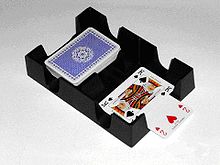Take off (playing cards)
Take off , engl. cut , French couper , hence also cutting or couping is a term from the card game , this is used in multiple meanings. The term cutting also denotes a certain type of mixing or occasionally mixing in general (see e.g. impact ).
Taking off after mixing
By picking up a deck of cards after shuffling, possible manipulation of the order of the cards by the shuffling player should be neutralized and thus avoided at the same time. The lifting off serves not only to avoid manipulation, but in particular to sink the top or bottom card, which could be recognized as a result of negligence during shuffling, in the middle of the stack .
Bridge, canasta, rummy and skat
Many card games have very strict rules on how to withdraw. B. at the bridge :
After shuffling the cards, the divider ( dealer ) places the package face up in front of his neighbor on the right. He now takes part of the package, but he must take at least four cards and leave at least four cards on the table, and places this part of the package next to it on the table. The divider - and not the player who withdrew (!) - now takes the part of the package that was originally at the bottom and places it on the lifted stack.
If a canasta tray is used for the canasta , the withdrawing player should pick up about a third of the package and place this part of the package in the card basket, the dealer then takes the rest, divides the cards and then puts the remaining pile on top of the canasta lifted part in the card basket.
The bottom card of the drawn pile may not be looked at in most games - there are exceptions in rummy , if the rule is that if a player finds a joker when drawing , they keep it ( rob it , not to be confused with the Exchanging a joker ), and in wading , where you can keep a "critical" (i.e. one of the top three cards).
Similar rules as in bridge exist in skat and many other games, whereby the minimum number of cards in the two piles varies widely.
Baccarat, Black Jack, Red Dog, Trente et quarante
In games such as Baccarat , Black Jack , Red Dog or Trente et quarante , as well as other casino games with six packs, the cards are cut ( couped ): the croupier takes the pile of cards and places it on the table so that the cards are on one long side lie on the table. A player takes the so-called cutting card ( Cut card , Carte de coupe ) and intersects into the card push, the actual lifting makes the croupier.
Scarne cut
Cardsharps have developed a variety of convincing methods to either fake a withdrawal or to reverse a real withdrawal. Cheating expert John Scarne therefore recommended the following procedure: with the scarne cut, the player taking the cut pulls the middle third out of the stack of cards and puts it on top of the package, then takes roughly the top half of the pile and puts the bottom part on top. This procedure is practically not inconspicuously reversible and at least protects against manipulation by the mixer. A possible conspiracy between the person mixing and the person taking off is made more difficult by this method. It goes without saying that the use of the Scarne cut does not offer any protection against other game-taking. ( Adapted from John Scarne: Scarne on Card Games , New York 1949/65, Courier Dover Publications Reprint 2004)
The drawing of seats or partnerships
If the seats are drawn before a game of cards or the partnerships in the case of bridge and canasta, the procedure for a very formal game is as follows: A player shuffles the package, takes off and spreads the stack out on the table in a crescent shape, then each player draws a card . This procedure is also referred to as cutting in English , and so the term lifting has become common in German as well .
Drawing cards
In the games of the Rummy family, Canasta or Mau-Mau , buying or drawing cards from the pile ( talon ) is also often referred to as taking off .
